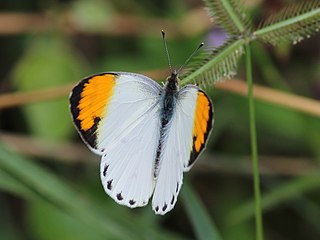
Acraea terpsicore, the tawny coster, is a small, 53–64 millimetres (2.1–2.5 in), leathery-winged butterfly common in grassland and scrub habitats. It belongs to the Nymphalidae or brush-footed butterfly family. It has a weak fluttery flight. It is avoided by most insect predators. This species and the yellow coster are the only two Indian representatives of the predominantly African tribe Acraeini. It is found in India, Sri Lanka, Indonesia, Maldives to Myanmar, Thailand, Laos, Cambodia, Vietnam, Bangladesh, Malaysia, Singapore, and recently Australia.

Hyarotis adrastus, the tree flitter, is a butterfly belonging to the family Hesperiidae found in South Asia and Southeast Asia.

Eutomis is a genus of moths in the subfamily Arctiinae. It contains the single species Eutomis minceus, which is found in South Africa.

Charaxes brutus, the white-barred emperor or white-barred Charaxes, is a butterfly of the family Nymphalidae. It is found in Africa.

Graphium policenes, the common swordtail or small striped swordtail, is a species of butterfly in the family Papilionidae (swallowtails). It is found in tropical Africa.

Charaxes xiphares, the forest king emperor or forest king charaxes, is a butterfly of the family Nymphalidae. It is native to Afromontane forest in the eastern and southern Afrotropical realm.

Colotis aurora, the sulphur orange tip or plain orange-tip, is a butterfly in the family Pieridae. It is found in Asia and Africa. The nominate subspecies, Colotis aurora aurora is found in India and Sri Lanka. The other subspecies, Colotis aurora evarne is found in Mauritania, Senegal, the Gambia, Mali, Burkina Faso, Ghana, Benin, Nigeria, Chad, Sudan, Ethiopia, Uganda, Kenya, Rwanda, Tanzania, the Democratic Republic of the Congo, Somalia, and southern Arabia.
Amerila vidua is a moth of the subfamily Arctiinae. It was described by Pieter Cramer in 1780. It is found in Cameroon, Democratic Republic of the Congo, Equatorial Guinea, Ethiopia, Ghana, Guinea, Ivory Coast, Kenya, Mauritius, Nigeria, Sierra Leone and Tanzania.
Episcepsis lenaeus is a moth of the family Erebidae. It was described by Pieter Cramer in 1780. It is found from Mexico to the Guianas.

Thyretes hippotes is a moth in the family Erebidae. It was described by Pieter Cramer in 1780. It is found in South Africa.

Crameria is a monotypic moth genus in the family Noctuidae erected by Jacob Hübner in 1819. Its only species, Crameria amabilis, was first described by Dru Drury in 1773.

Zamarada eucharis is a species of moth in the family Geometridae. It was first described by Dru Drury in 1782, from Sierra Leone. It is found in Ivory Coast, Ghana, Guinea, Liberia and Sierra Leone
Phiala hologramma is a moth in the family Eupterotidae. It was described by Per Olof Christopher Aurivillius in 1904. It is found in the Democratic Republic of the Congo (Katanga) and Zimbabwe.
Phiala venusta is a moth in the family Eupterotidae. It was described by Francis Walker in 1865. It is found in Sierra Leone.

Hibrildes crawshayi is a moth in the family Eupterotidae. It was described by Arthur Gardiner Butler in 1896. It is found in the Democratic Republic of the Congo (Katanga), Malawi, South Africa, Tanzania, Zambia and Zimbabwe.
Stenoglene pellucida is a moth in the family Eupterotidae. It was described by James John Joicey and George Talbot in 1924. It is found in Cameroon and the Democratic Republic of the Congo (Orientale).
Hypatima formidolosa is a moth in the family Gelechiidae. It was described by Edward Meyrick in 1916. It is found in the South African provinces of KwaZulu-Natal, Mpumalanga, and Gauteng.

Sphingomorpha chlorea, the sundowner moth, is a species of moth in the family Erebidae that is native to Africa and southern Asia. The species was first described by Pieter Cramer in 1777. It is a fruit-piercing moth and a notorious pest in orchards. The fruit is pierced while performing a vertical and rhythmic movement of the head.











